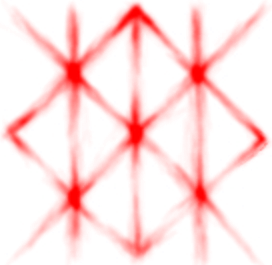26. The Gods and the Giants
Primeval cow Auðumbla collects emerald Love in her left breast (upper tip of Berkana) and a golden-white shining Crystal in her right one (lower tip of Berkana).
Thurs Rune
She feeds the giant Ymir who always sleeps.
Interestingly, in the Icelandic rune poem about the rune Thurs, there is a reference to Saturn born of Terra (Mother Earth) and Caelus (Father Sky).
As you see, the Thurs rune consists of a vertical bar and two diagonal bars that start in the Air (Sky) and the Earth. They meet in the Emptiness, which is the division line and source of order. This is already the third crossing point on the level of emptiness:
- The first was the starting tip of Kenaz, the initial separation of Water from Fire, so Emptiness emerged in between causing the first degree of order: "here" vs "there."
- The second was the center of the entire Stone, the point of the Dawn, where Earth evolves into Crystal and Light, the spirit of the Fire, is filtered through the Earth-Crystal and ascends to the Air. Again, this point was an act of order. Chaotic dark Earth, through ordering, became transparent and hard Crystal, and the rising Sun brought clarity to the dark world.
- The third point is where Thurs is pointing to. It's not mentioned in the Norse myth, but accepting the parallel drawn with Roman/Greek myth, this point is the beginning of Time as we mortals experience it.
As suggested by scholars, the name Ymir can be traced down to Proto-Indo-European *ym̥H-yo- "twin" and then to Yama, the first man who died and subsequently became the Hindu god of death. His name, Yama also means "twin" and he has a twin sister Yami, the Hindu goddess of Life. Another name for Yama is Kala - it means "time" which reinforces the connection with Saturn.
Perthro Rune
According to Norse myth, Ymir, while sleeping, is giving life to numerous children, and doing this solo. It aligns well with the "twin" meaning of his name roots. It seems Ymir contains both twins, including Yami's aspect of Life.
By the way, Auðumbla licks ice blocks and at some point reveals Búri out of the Ice, the ancestor of the Æsir gods. This story is the first time when a specific time is mentioned: Búri gradually appears from the ice over three days. It indirectly supports our version of the connection between Ymir and the beginning of time, as suggested by comparison with Saturn.
These two independent branches of Gods and Giants are represented by the upper and lower hands of the rune Perthro:
The name and meaning of the Perthro rune are unclear from Norse sources. One version is a "pear tree" or more generally a "fruit tree" (e.g., apple tree). From a Runic Alchemical point of view, the tree interpretation is also supported by:
- Sharing the trunk and top bar with the other two tree runes Eihwaz and Berkana.
- Sharing two bars, top and bottom, with Berkana.
- Vertical symmetry representing crown and roots. All tree runes have a sort of vertical symmetry, which is mirrored in the case of Eihwaz.
Another version is a sort of wooden board game or dice.
Let's look at all the transitions happening in this rune:
Water comes to the Air and bounces back to the Water. The same for the Fire traveling to the Earth and returning. But in both cases, they are not the same as they were on departure. The Water acquires something from the Air and the Fire from the Earth. I believe this is how worlds of Water and Fire become inhabited—they now contain some shapes. Surtr, the giant of Fire, is born by the dreaming Ymir, so Fire has its "avatar." Búri, the early god of the Water, is shaped by Auðumbla and starts the line of all the gods.
Overall, based on the above, we can describe the rune Perthro as fruits, offspring, cause-effect, side-effect, aspect, story, and fate.
